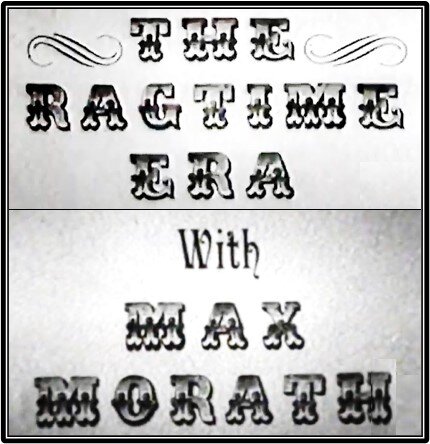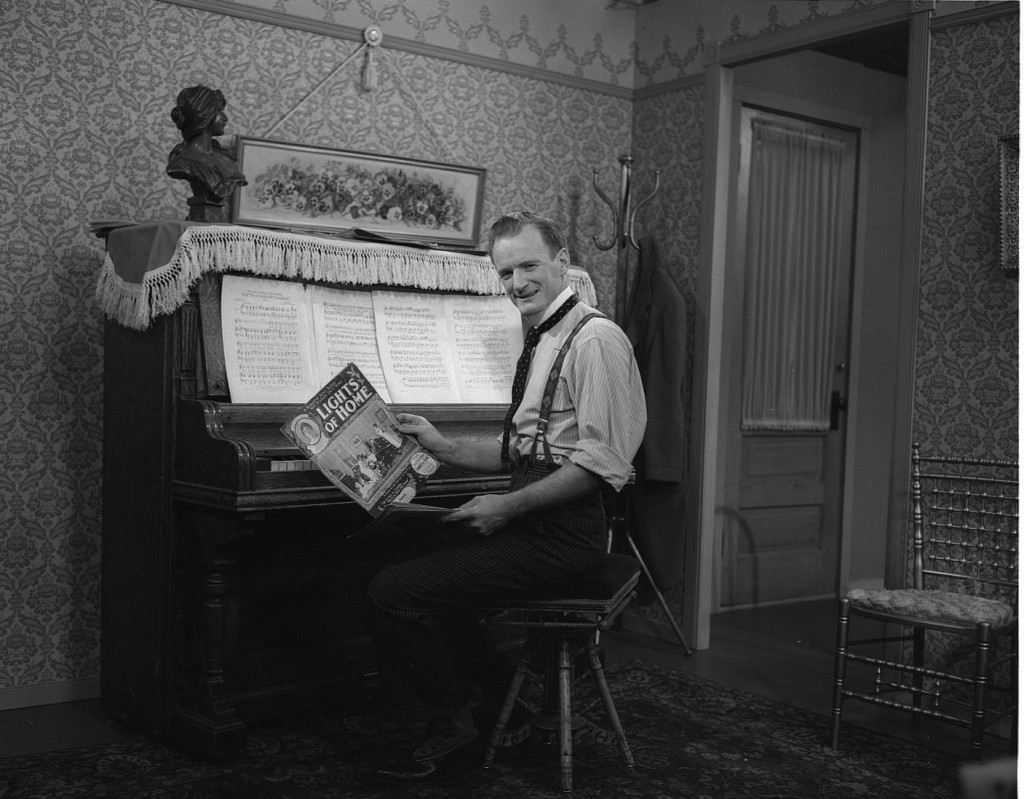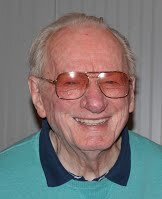In the Ragtime Years when a great personality celebrity died, word would quickly spread through the entertainment districts, Variety shows might be interrupted to report the sad news and have a moment of silence to remember the departed personality. At night theater lights might be dimmed for a few seconds in remembrance and everywhere artists and audiences, crews and office workers, and many people just on the street would pause to tell a story or relate a memorable incident regarding the deceased. Word would have spread rapidly by word of mouth, or by Mr. Bell’s talking device or Mr. Morse’s telegraph and it would all be followed by wakes and memorial affairs across the land.
Well, these aren’t the ragtime years, but we have lost a great entertainer who taught us about those times and entertained us with the songs and stories of that era. Max Morath in his 96th year has made his final exit, so to help assuage my grief, I will stop right here and share my memories about our friend Max.
We first met at the 1968 Ragtime Festival on the St. Louis Riverfront and again in Atlanta at the 1972 premiere of Joplin’s opera Treemonisha. He has been in my life for well over 50 years and Max was a treasured friend as he was to so many thousands of others around the world.
I first worked with Max when he helped us organize the inaugural Scott Joplin Ragtime Festival in Sedalia back in 1974. There are so many stories from his career, and it has been a privilege to hear him describe many of them over Mr. Bell’s “machine,” in recent years. I have had many wonderful experiences with Max this past half century of his life, and for over two years, our daily phone calls have allowed us to share many of our life stories. Some (okay many) of those accounts have been repeated several times as our declining memories failed us and we enjoyed the telling all over again. We would eventually end our daily visits, anticipating the next with my, “Later Max,” to his “Take care, ma’boy.”
Many will always remember seeing Max on stage, or on television, or perhaps hearing him on the radio. Max is also familiar because of his many recordings going back 70 years, or from his books and articles and the volume of record and CD liner notes and book prologues he wrote.
However, as I recall Max’s remarkable life, I visualize him as a child rummaging through his mother’s piano bench. He was fond of reminding me that Gladys was a silent film piano player back in Cripple Creek Colorado where Max was born. His mother introduced him, and in a very real way America, to ragtime and the era that nurtured it. He was a roaming balladeer teaching us about our musical heritage and entertaining us at the same time.
I can see Max “headlining” his fourth-grade play, Sonny Elephant, during his year in Long Beach, California after his parent’s divorce. This may have been the experience that enticed him into a life on the boards.
Back in Cripple Creek, I remember his stories of trekking up Cheyenne Mountain or Pike’s Peak and then running all the way back down. Max always loved to hike the back country of America. I see him as a boy mesmerized by fireworks erupting from Pike’s Peak every new year. The pyrotechnics were the work of his father Fred who was a co-founder of the AdAmAn club of hikers. The capital “A” represented the Colorado peaks and the group had begun the annual fireworks display back in 1922. In 1947 Max described the display flying over Pike’s Peak while broadcasting for radio station KVOR aboard a military C-47 from Carson Air Base.
In my mind I can see Max performing with his 1943 barbershop quartet and his high school mate. Charlie Morrow. My very favorite image of these two pals is of an afternoon in a particularly boring high school Latin class when the two friends decided to jump out the open first floor window and escape. Outside they had a change of intent however and jumped back in before their teacher was aware of their bit of Huck Finn and Tom Sawyer mischief. Max and Charlie had ambitions to be scientists or engineers, and Charlie achieved that goal and led NASA into the twenty-first century. Max, of course, became an entertainer and took us straight back to the 1890s.
I can imagine Max going through the latest boys’ magazines with another boyhood friend, Jordon Bayless at Musick’s Drug Store and having a soda at the fountain. Or I see the boys biking out to the Garden of the Gods for an afternoon of amazement among the sandstone sculptures.
His favorite teacher in high school was Rowena Dashwood Graves, a tall, statuesque lady of bearing once married to President Chester Alan Arthur’s son. She was a strict speech teacher without being severe and her last assignment every semester was for each student to give a five-minute speech before the class. It was nearly Max’s undoing. I can picture the moment as he described it, “an eternity of terror,” standing before the class when she told him to proceed. Nevertheless, she was always his favorite teacher and I imagine her good grade and words of praise was a major catalyst that led to Max’s career in entertainment. He thrived before audiences.

Max was a paper boy for a time, and I can imagine him throwing the Daily Cripple Creek Times-Record as he said, “in rain, snow or heat of summer.” He would then happily collect the payments on Saturday mornings, and then cut grass in the neighborhood afternoons to earn a little more cash. Max was a born businessperson.
I recall Max describing his job as a disc jockey on Colorado Springs KVOR radio while still in high school, and I can hear him remembering one incident just before a midnight sign-off. The studio phone rang, and it was the composer Vincent Youmans thanking Max for playing the composer’s old songs. Youmans was in a nearby Tuberculosis Sanitorium listening to Max’s late-night program in Denver.
Max was fascinated by the technology of communication, and he always maintained that technology drives entertainment. He studied each medium and understood the elements of performance from both sides of a microphone or camera.
Max moved to daytime radio after high school and while he was attending Colorado College, his programs were often remotely broadcast from an advertisers place of business. Young Max was billed as “…the BRIGHTEST SPOT in any housewife’s afternoon!”
He earned his bachelor’s degree in English in 1951. While Max was in college, he became totally involved in melodrama theater at the old Cripple Creek Imperial Hotel in the Gold Bar Room. He was the house pianist, sometime director, narrator, and occasional actor. These summer shows were very popular with tourists and along with his early recordings and occasional performance tours his fame began to grow across the county.
In the mid-1950s the Moraths moved briefly to St. Petersburg, Florida, where Max did radio shows by day and as “Skeets” Morath he played the piano bar in Davy Jones’ Locker. The owner thought there were too many Maxes entertaining in those days.
From radio to television to national fame as a performer, Max became the recognized purveyor of music and popular culture of the ragtime era. That is the way most people remember Max Morath or as Rudi Blesh dubbed him, “Mr. Ragtime.”

In 1959, his epic 12-episode TV series The Ragtime Era, was the first modern educational documentary at KRMA-TV in Denver that both entertained and informed. It ushered in a field now produced by modern documentarians like Ken Burns at Florentine Films. Max wrote, hosted, and performed each 30-minute episode live in one-take and followed that series with other TV projects.
He pioneered educational television with his producer Moss Hall and his series helped move the transition from National Educational Television (NET) to the Public Broadcasting System (PBS). Max was honored as a PBS founder when he was chosen to be the final act at the PBS 25th anniversary gala.
David Stewart in his history of PBS said Max showed public television how to have fun. I eagerly watched each program in Kansas City never dreaming I would come to know Max personally a decade later.
Max moved to New York in the early 1960s and quickly learned he had to play the clubs to get bigger engagements. He began by appearing with Woody Allen at Max Gordon’s Blue Angel nightclub and later at the Village Vanguard, among others. He also established a studio which was coincidentally near Dick Hyman’s and the great performers became lifelong friends.
From his New York base Max’s career soared. Perhaps he is best remembered for his one man shows that he toured from 1969 to 2007. One of my favorite memories of being with Max was from the mid-1970s, when I spent several days driving him to nightly performances in venues on the Great Plains through Kansas and Nebraska.
Watching him unpack all his props and publicity material for each show every afternoon after having traveled several hundred miles, was a study in professionalism. He would then put on a performance in a high school auditorium, church hall, or occasionally an actual theater.
His performances were flawless, no matter the limitations he encountered, and his stage presence and timing were impeccable. He could read an audience from the first few minutes of a performance and usually left with a standing ovation. The book Max Morath on the Road to Ragtime (1999) he co-authored with his amazing wife Diane Skomars provides a bit of that “on the road” experience. Diane is a professional photographer, and her images profusely illustrate the narrative.

While playing the clubs Max researched, wrote, produced, and performed a series of popular one-man shows, one evolving after another. He rotated his on-the-road work with his club appearances and usually acted as his own business manager, advertising agent, negotiator, scheduler, and billing agent. Much of that time he was on the road. He did thousands of performances of “Max Morath at the Turn of the Century,” “The Ragtime Years,” “Living a Ragtime Life,” “The Ragtime Man,” “Ragtime Revisited,” and “Ragtime and Again.” He toured until 2007, though at age 81 he continued to speak and lecture on music, history, and the popular culture of the ragtime years, finally retiring in 2016.
I have neglected to mention the hundreds of radio and TV appearances he made during that period. He was a popular guest on the Bell Telephone Hour, the Kraft Music Hall, the Today and the Tonight Shows, many of the celebrity named variety shows, and he made frequent contributions to NPR and PBS programming. For many years he was a regular guest on the Arthur Godfrey Radio Show and later Godfrey’s afternoon TV program.
Max always credited his success to good luck, but I’ve come to realize he worked hard for “lady luck.” First, he was always fascinated by the latest technology involved with entertainment. He sought it out, learned how to employ it and he was always learning something new as in 1950 when he attended the Stanford University-NBC Television Academy. He also had an amazing business acumen. Max learned it all on the job, from publicity to accounting, and everything in between. With those skills and being a seasoned entertainer, he quickly rose to even greater national fame.
 Max ended his career with 32 record albums to his name and he wrote the album notes for many others. His breakthrough recordings however were for the Solomon brothers on the Vanguard label, The World of Scott Joplin, (2 records, 1972) and The Best of Scott Joplin (1973).
Max ended his career with 32 record albums to his name and he wrote the album notes for many others. His breakthrough recordings however were for the Solomon brothers on the Vanguard label, The World of Scott Joplin, (2 records, 1972) and The Best of Scott Joplin (1973).
I have so many favorites among his recordings, but I think the 1978 New World Records album Don’t Give the Name a Bad Place he did with Dick Hyman is quintessential Morath. It’s novelty numbers provide clear insight into the culture of pre-1900 America and afforded two friends an opportunity to collaborate on a project.
These records along with all his previous work helped usher in the ragtime and Scott Joplin revival of the 1960s and 1970s. My contact with Max began at this time and he was indeed a perfect ambassador for the music and our popular culture. Max was a humble celebrity and always credited the work of minority composers and entertainers who aided his own career.
Max was an accomplished composer as well and he gave us some delightful syncopations over the years, including his Cripple Creek Suite acknowledging his origins and some of the people dear to him. Max’s friend Aaron Robinson produced a CD of Max’s complete ragtime compositions (2015) and Sue Keller and Jeff Barnhart recently recorded a CD of Max’s compositions titled, Return to Cripple Creek (2017).
During his long career he published numerous folios of sheet music including his own. My favorite is his first, Max Morath’s Guide to Ragtime (Hollis, 1964). As was typical of Max he included the works of new composers like Peter Lundberg’s “Hippocampus Rag.” Max spent his life encouraging and inspiring others in their endeavors and he often personally mentored and aided young musicians.

In addition to his creative talents, Max was an intense and dedicated scholar. I have recently begun collecting the massive body of writing Max produced in his career as album liner notes, book prologues, promotional material for corporations, and other jottings too numerous to list. At the age of 70 he completed a master’s degree from Columbia University that resulted in his book I Love You Truly on the life and work of Carrie Jacobs Bond. He was one of the first to recognize and acknowledge the talented women composers and performers of ragtime which his 1977 Vanguard album The Ragtime Women celebrates. Max also authored The NPR Curious Listeners Guide to Popular Standards (2002).
Max finally retired from all personal appearance work in 2017 but he was hardly inactive. He spent his last years finishing up projects long dear to him. He completed, with his old Ragtime Era TV series producer Moss Hall, a screenplay titled Blind Boone, that won a first prize at a Nashville Film Festival. Finally, he finished a work he considered very important, the “translation” and transcription of Finley Peter Dunn’s editorial writing as “Mr. Dooley.” Dooley was a character Max often quoted in his one-man shows. He also finished writing a stage musical titled, Cut the Cards: A Musical Review.
Max always spoke sweetly of his first wife Norma and he dearly loved their three children, Kathy, Christy, and Fred, his grandchildren, and his step daughter Monette and her daughter. His wife Diane Skomars was his other great love and Diane has nurtured and inspired Max for over 30 years.
Diane has written a book titled Have I Told You Everything I Know, inspired by a 9/11 experience. Max was on the tarmac in New Jersey aboard the next plane that was to take off after the infamous Pennsylvania terrorist flight. Diane spent that awful day not knowing if Max was on the ill-fated plane until he finally arrived home hours later.
Max moved to Duluth, Minnesota when he remarried, and Max and Diane have many close friends there today.
In 2016 Max was inducted into the Colorado Music Hall of fame. Until the end he was doing what he had always been doing…encouraging and inspiring everyone around him to develop their gifts and entertain a world in need of their talents.
Now as I finish this reminiscence, I remember Max’s family, especially Diane, Kathy, Christy and Fred. Their loss is the greatest and the richest for loving Max as husband and father.
 For the rest of us, W.B. Yeats wrote in his poem “Beautiful Lofty Things” of those individuals he had most admired in his life and referred to them as “all the Olympians.” Yeats was equating their greatness to the prominent deities of the Greek pantheon residing on Mount Olympus. Max was our Olympian from Cripple Creek, Colorado, astride Pike’s Peak in our pantheon of great American entertainers.
For the rest of us, W.B. Yeats wrote in his poem “Beautiful Lofty Things” of those individuals he had most admired in his life and referred to them as “all the Olympians.” Yeats was equating their greatness to the prominent deities of the Greek pantheon residing on Mount Olympus. Max was our Olympian from Cripple Creek, Colorado, astride Pike’s Peak in our pantheon of great American entertainers.
I don’t know what the doctors will put down as his cause of death. However, I would write that Max died of a tireless 96-year mission to bring joy to a world desperately in need of his gifts.
“Later Max”
(“Take care, ma’boy”)
Larry Melton was a founder of the Scott Joplin Ragtime Festival in 1974 and the Sedalia Ragtime Archive in 1976. He was a Sedalia Chamber of Commerce manager before moving on to Union, Missouri where he is currently helping to conserve the Ragtime collection of the Sedalia Heritage Foundation. Write him at lcmelton67@gmail.com.






















